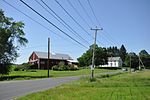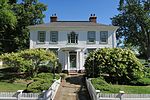Mount Holyoke

Mount Holyoke, a traprock mountain, elevation 935 feet (285 m), is the westernmost peak of the Holyoke Range and part of the 100-mile (160 km) Metacomet Ridge. The mountain is located in the Connecticut River Valley of western Massachusetts, and is the namesake of nearby Mount Holyoke College. The mountain is located in the towns of Hadley and South Hadley, Massachusetts. It is known for its historic summit house, auto road, scenic vistas, and biodiversity. The mountain is crossed by the 110-mile (180 km) Metacomet-Monadnock Trail and numerous shorter trails. Mount Holyoke is the home of J.A. Skinner State Park which is accessible from Route 47 in Hadley, Massachusetts.
Excerpt from the Wikipedia article Mount Holyoke (License: CC BY-SA 3.0, Authors, Images).Mount Holyoke
NET/M&M Trail (white),
Geographical coordinates (GPS) Address Website Nearby Places Show on map
Geographical coordinates (GPS)
| Latitude | Longitude |
|---|---|
| N 42.300833333333 ° | E -72.586944444444 ° |
Address
Joseph Allen Skinner State Park (J.A. Skinner State Park)
NET/M&M Trail (white)
01060
Massachusetts, United States
Open on Google Maps








